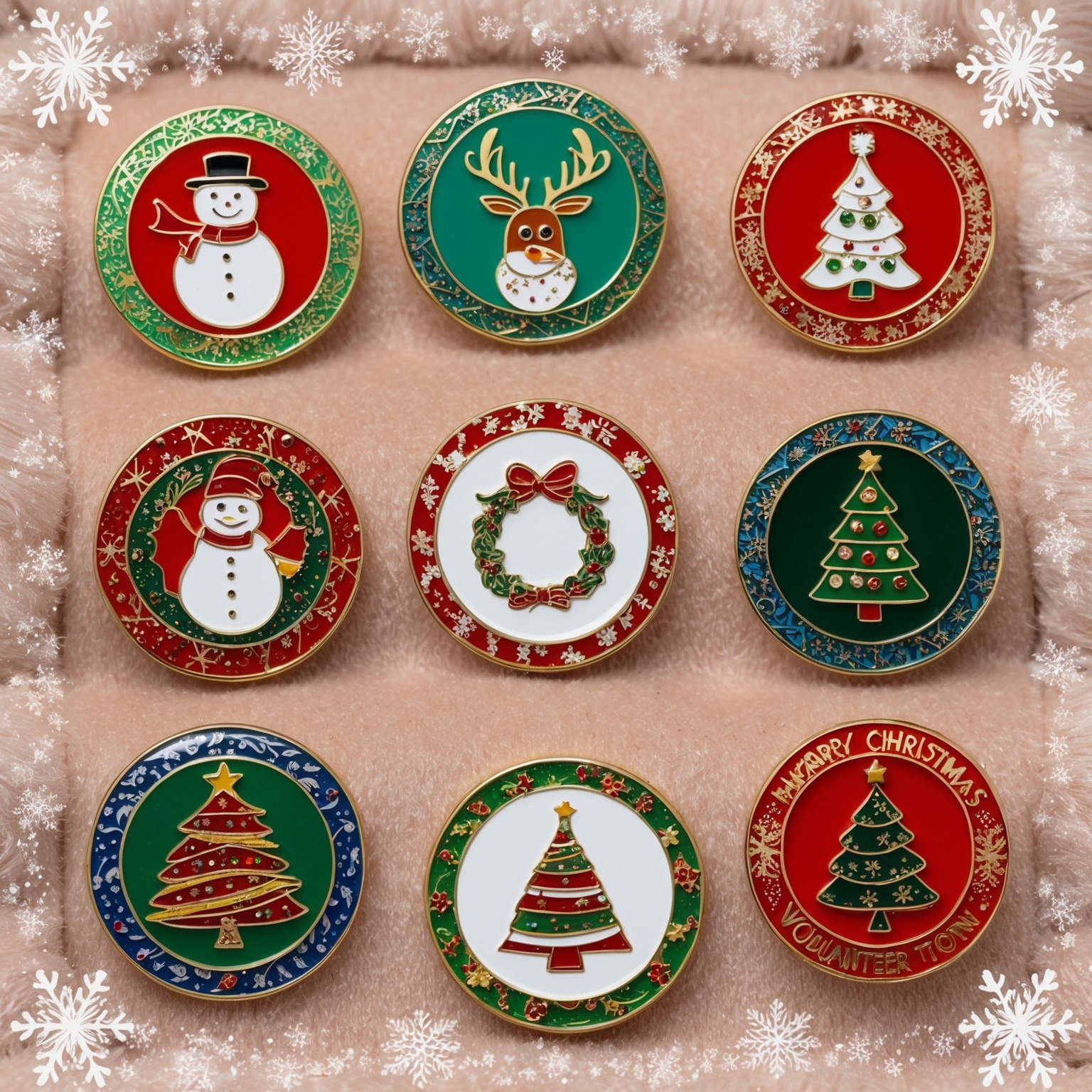Trading pins are more than just collectible items; they are symbols of camaraderie, team spirit, and shared experiences. For decades, these small, decorative pieces of metal have played a significant role in sports, entertainment, and even corporate cultures, fostering connections and celebrating achievements. Among the vast array of trading pins, some have achieved iconic status, becoming highly sought-after items that tell unique stories about the events, teams, and moments they represent.
In this article, we will explore the legacy of iconic trading pins, delving into the stories behind some of the most famous designs in history. From the Little League World Series to the Olympic Games, these pins have captured the hearts of collectors and fans alike, serving as tangible reminders of unforgettable experiences. By understanding the history and significance of these iconic trading pins, we can gain a deeper appreciation for their role in preserving the memories and traditions of the events they commemorate.
The Origins and Evolution of Trading Pins
The Early Days of Trading Pins
The tradition of trading pins dates back to the late 19th and early 20th centuries, with roots in both the sports and entertainment industries. The concept of using pins as symbols of affiliation or achievement can be traced back to military and fraternal organizations, where pins were worn to signify membership and rank. However, the idea of trading pins—exchanging them as a form of social interaction—began to take shape in the world of sports.
One of the earliest examples of trading pins in sports comes from the Olympic Games. In the early 1900s, athletes, coaches, and officials began exchanging pins as a gesture of goodwill and friendship. These pins, often featuring the flags or emblems of the participating countries, became a popular way for individuals to connect and commemorate their involvement in the Games. Over time, the practice of trading pins spread to other sports, particularly baseball and hockey, where teams and fans would exchange pins as a way to show support and celebrate the spirit of competition.
The Rise of Trading Pins in the 20th Century
The 20th century saw the widespread adoption of trading pins across various sports and events. Little League Baseball, founded in 1939, played a significant role in popularizing trading pins among young athletes and their families. Each year, teams from across the United States and around the world would create custom-designed pins to represent their hometowns or regions. These pins would then be traded with other teams during the Little League World Series, fostering a sense of community and sportsmanship among the players.
As the popularity of trading pins grew, so did the diversity of their designs. Teams, events, and organizations began to create increasingly intricate and creative pins, incorporating elements such as team mascots, logos, and even moving parts. The tradition of trading pins expanded beyond baseball to include other sports, such as softball, soccer, and hockey, as well as events like Disney’s pin trading culture and corporate conventions.
The Modern Era of Iconic Trading Pins
In the modern era, trading pins have become a global phenomenon, with collectors and enthusiasts eagerly seeking out the most unique and iconic designs. Advances in technology have allowed for more detailed and customizable pins, resulting in a wide variety of styles, from classic enamel pins to 3D molded designs. The tradition of trading pins has also been embraced by new communities, such as esports and fan conventions, where pins serve as both collectibles and badges of identity.
Despite the evolution of trading pins over the years, their core purpose remains the same: to celebrate shared experiences, build connections, and preserve the memories of special moments. Whether exchanged at a sports tournament, an amusement park, or a fan convention, trading pins continue to hold a special place in the hearts of those who collect them.
The Stories Behind Iconic Trading Pins
1. The Olympic Games: A Tradition of Global Friendship
The Legacy
The Olympic Games are perhaps the most famous stage for trading pins, with a tradition that dates back over a century. Every two years, athletes, coaches, officials, and spectators from around the world come together to celebrate the pinnacle of sporting achievement. For many, the exchange of Olympic pins is a cherished part of the experience, symbolizing the spirit of international friendship and unity.
The Iconic Trading Pin
One of the most iconic Olympic trading pins is the “Olympic Rings” pin, featuring the five interlocking rings that represent the continents of the world. The design, which was introduced at the 1920 Antwerp Games, has become a universal symbol of the Olympics and is featured on countless pins created for each edition of the Games.
Another highly sought-after Olympic trading pin is the “Mascot Pin,” which features the official mascot of the host city. For example, the 1980 Lake Placid Games featured the raccoon mascot “Roni,” while the 2000 Sydney Games had the trio of mascots “Syd,” “Millie,” and “Olly.” These pins often capture the unique cultural and artistic elements of the host city, making them valuable collectibles for pin enthusiasts.
2. Little League World Series: Celebrating Youth Baseball
The Legacy
The Little League World Series (LLWS) is one of the most prestigious youth baseball tournaments in the world, attracting teams from across the globe. Since its inception in 1947, the LLWS has become synonymous with sportsmanship, teamwork, and the joy of playing baseball. Trading pins have been a key part of the tournament’s culture, with players, coaches, and families eagerly exchanging pins as a way to commemorate their participation.
The Iconic Trading Pin
One of the most iconic trading pins from the Little League World Series is the “Championship Pin,” awarded to the team that wins the tournament. These pins are often larger and more elaborate than regular team pins, featuring the tournament’s logo, the year of the victory, and sometimes even the names of the players. The Championship Pin is a coveted item among collectors and serves as a lasting reminder of a team’s triumph on the world stage.
Another popular trading pin at the LLWS is the “Home Plate Pin,” which typically features the shape of a home plate and includes the team’s name, mascot, and colors. These pins are often designed to reflect the unique identity of each team, making them highly sought-after by collectors who attend the tournament.
3. Disney Pin Trading: Magic and Collectibility
The Legacy
Disney pin trading is a beloved tradition that began in the late 1990s at Walt Disney World Resort in Florida. What started as a small activity for guests quickly grew into a global phenomenon, with Disney fans eagerly collecting and trading pins featuring their favorite characters, attractions, and events. Today, Disney pin trading is a key part of the Disney theme park experience, with thousands of pins available for purchase and trade.
The Iconic Trading Pin
One of the most iconic Disney trading pins is the “Cinderella Castle Pin,” which features the iconic castle that serves as the centerpiece of Walt Disney World. This pin is a must-have for Disney fans, symbolizing the magic and wonder of the park. The design often includes intricate details, such as the castle’s turrets and surrounding fireworks, making it a stunning collectible.
Another iconic Disney trading pin is the “Mickey Mouse Ear Hat Pin,” which features the classic black ear hat worn by Mickey Mouse. This pin is a symbol of Disney’s legacy and is often customized with different colors, patterns, and character designs. The Ear Hat Pin is a favorite among collectors and is frequently traded at Disney parks and events.
4. NHL All-Star Game: Showcasing Hockey’s Best
The Legacy
The NHL All-Star Game is an annual event that brings together the best players from the National Hockey League for a showcase of skill and competition. Trading pins have become an integral part of the All-Star Game experience, with fans and collectors exchanging pins that represent the host city, the participating teams, and the league itself.
The Iconic Trading Pin
One of the most iconic trading pins from the NHL All-Star Game is the “All-Star Logo Pin,” which features the official logo of the event. These pins are often designed to reflect the unique characteristics of the host city, incorporating elements such as landmarks, colors, and cultural symbols. For example, the 2017 All-Star Game in Los Angeles featured a pin with the LA skyline and a star-studded background, paying homage to the city’s Hollywood heritage.
Another popular trading pin at the NHL All-Star Game is the “Player Jersey Pin,” which features the jersey number and name of a specific All-Star player. These pins are highly collectible, especially when they represent star players or future Hall of Famers. Fans often seek out these pins as a way to commemorate their favorite players and celebrate their inclusion in the All-Star Game.
5. FIFA World Cup: The Global Game’s Pinnacle
The Legacy
The FIFA World Cup is the most prestigious tournament in international soccer, bringing together the best teams from around the world to compete for the coveted trophy. Trading pins have been a popular part of the World Cup experience for decades, with fans, players, and officials exchanging pins that represent their countries and celebrate the spirit of the tournament.
The Iconic Trading Pin
One of the most iconic trading pins from the FIFA World Cup is the “World Cup Trophy Pin,” which features a miniature version of the tournament’s famous trophy. This pin is a symbol of the ultimate prize in soccer and is highly sought-after by collectors and fans alike. The design often includes the tournament year and the host country’s flag, making it a valuable memento of the event.
Another iconic FIFA World Cup trading pin is the “National Flag Pin,” which features the flag of a participating country. These pins are often traded among fans from different countries, serving as a symbol of international friendship and sportsmanship. Collectors often aim to acquire flag pins from every participating nation, creating a complete set that represents the global nature of the World Cup.
6. World Series of Poker: High Stakes and High Collectibility
The Legacy
The World Series of Poker (WSOP) is the most prestigious poker tournament in the world, attracting top players and amateurs alike to compete for millions of dollars in prize money and the coveted WSOP bracelet. Trading pins have become a popular way for players and fans to commemorate their participation in the tournament and celebrate their love of the game.
The Iconic Trading Pin
One of the most iconic trading pins from the World Series of Poker is the “WSOP Bracelet Pin,” which features a miniature version of the gold bracelet awarded to the tournament’s champions. This pin is a symbol of poker excellence and is highly coveted by players and collectors. The design often includes the WSOP logo and the year of the tournament, making it a valuable keepsake.
Another popular trading pin at the WSOP is the “Poker Chip Pin,” which features a design resembling a poker chip with the WSOP logo in the center. These pins are often traded among players and fans as a way to celebrate their participation in the tournament and their love of the game. The Poker Chip Pin is a favorite among collectors, especially when it represents a specific event or year.
7. MLB All-Star Game: A Celebration of Baseball’s Best
The Legacy
The MLB All-Star Game, also known as the “Midsummer Classic,” is an annual event that brings together the best players from Major League Baseball for a showcase of talent and skill. Trading pins have become a cherished part of the All-Star Game tradition, with fans and collectors eagerly seeking out pins that represent the host city, the participating teams, and the league’s stars.
The Iconic Trading Pin
One of the most iconic trading pins from the MLB All-Star Game is the “All-Star Logo Pin,” which features the official logo of the event. These pins often incorporate elements that reflect the host city’s culture and heritage, such as landmarks, colors, and symbols. For example, the 2016 All-Star Game in San Diego featured a pin with the city’s famous waterfront and a surfboard, celebrating San Diego’s coastal culture.
Another popular trading pin at the MLB All-Star Game is the “Player Autograph Pin,” which features the signature of a specific All-Star player. These pins are highly collectible, especially when they represent star players or future Hall of Famers. Fans often seek out these pins as a way to commemorate their favorite players and celebrate their inclusion in the All-Star Game.
8. Super Bowl: The Pinnacle of American Football
The Legacy
The Super Bowl is the most watched sporting event in the United States, and it is considered the pinnacle of American football. Trading pins have become an integral part of the Super Bowl experience, with fans, players, and collectors exchanging pins that represent the participating teams, the host city, and the event itself.
The Iconic Trading Pin
One of the most iconic trading pins from the Super Bowl is the “Super Bowl Logo Pin,” which features the official logo of the event. These pins are often designed to reflect the unique characteristics of the host city, incorporating elements such as landmarks, colors, and cultural symbols. For example, the 2018 Super Bowl in Minneapolis featured a pin with the city’s iconic skyline and snowflakes, paying homage to Minnesota’s winter weather.
Another highly sought-after Super Bowl trading pin is the “Team Helmet Pin,” which features the helmet of one of the participating teams. These pins are often traded among fans of the competing teams and are a symbol of loyalty and support. Collectors often aim to acquire helmet pins from every Super Bowl, creating a complete set that represents the history of the event.
9. Comic-Con: Celebrating Pop Culture
The Legacy
Comic-Con International, held annually in San Diego, is one of the largest and most famous pop culture conventions in the world. It celebrates everything from comics and movies to video games and television, attracting fans and creators from around the globe. Trading pins have become a popular part of the Comic-Con experience, with attendees eagerly seeking out pins that represent their favorite characters, franchises, and events.
The Iconic Trading Pin
One of the most iconic trading pins from Comic-Con is the “Comic-Con Logo Pin,” which features the official logo of the event. These pins often incorporate elements that reflect the diverse range of pop culture represented at the convention, from superheroes to sci-fi and fantasy. The design often includes the year of the event and is a must-have for Comic-Con attendees and collectors.
Another popular trading pin at Comic-Con is the “Character Pin,” which features a specific character from a popular franchise, such as Marvel, DC, Star Wars, or Harry Potter. These pins are highly collectible and are often traded among fans who share a love for the same characters and stories. The Character Pin is a favorite among collectors and is often released in limited editions, making it a valuable addition to any collection.
10. World Expo: A Showcase of Innovation and Culture
The Legacy
The World Expo, also known as the World’s Fair, is an international event that showcases the achievements and innovations of nations from around the world. Trading pins have been a popular part of the World Expo experience for decades, with attendees exchanging pins that represent the participating countries, pavilions, and exhibits.
The Iconic Trading Pin
One of the most iconic trading pins from the World Expo is the “Expo Logo Pin,” which features the official logo of the event. These pins often incorporate elements that reflect the theme and host city of the Expo, such as landmarks, colors, and cultural symbols. For example, the 2010 Shanghai World Expo featured a pin with the city’s famous skyline and the Expo’s theme of “Better City, Better Life.”
Another popular trading pin at the World Expo is the “National Pavilion Pin,” which features the flag or emblem of a participating country’s pavilion. These pins are often traded among attendees from different countries, serving as a symbol of international friendship and cultural exchange. Collectors often aim to acquire pavilion pins from every participating nation, creating a complete set that represents the global nature of the World Expo.
The Cultural Impact of Iconic Trading Pins
Building Connections and Fostering Community
One of the most significant cultural impacts of trading pins is their ability to build connections and foster a sense of community among individuals from diverse backgrounds. Whether exchanged at a sports tournament, a fan convention, or an international event, trading pins serve as a way for people to connect, share stories, and celebrate shared interests.
The act of trading pins often leads to meaningful interactions and friendships, as individuals bond over their love of a particular team, event, or character. This sense of community is especially evident at large gatherings like the Olympic Games, the Little League World Series, and Comic-Con, where pin trading becomes a central part of the experience.
Preserving Memories and Celebrating Achievements
Trading pins also play a crucial role in preserving memories and celebrating achievements. Each pin represents a specific moment in time, whether it’s a team’s victory, a player’s performance, or a fan’s attendance at a once-in-a-lifetime event. By collecting and trading pins, individuals can create a tangible record of their experiences, allowing them to relive those moments and share them with others.
For athletes and participants, trading pins are often a symbol of their hard work, dedication, and success. Whether it’s a Championship Pin from the Little League World Series or a Medalist Pin from the Olympic Games, these pins serve as a lasting reminder of the achievements that defined their journey.
Inspiring Creativity and Innovation
The design and creation of trading pins have inspired a great deal of creativity and innovation over the years. As teams, events, and organizations seek to create the most unique and memorable pins, designers have pushed the boundaries of what’s possible, experimenting with new materials, shapes, and features.
This creativity has led to the development of iconic trading pins that are not only visually stunning but also rich in meaning and symbolism. From the intricate details of Disney’s character pins to the cultural references in World Expo pavilion pins, these designs reflect the diverse and dynamic world we live in.
The Enduring Legacy of Iconic Trading Pins
The legacy of iconic trading pins is one of connection, celebration, and creativity. These small, decorative pieces of metal have played a significant role in sports, entertainment, and global events, serving as symbols of shared experiences and collective memories. From the Olympic Games to the Little League World Series, from Disney parks to Comic-Con, trading pins have become an integral part of the cultural fabric, bringing people together and preserving the moments that matter most.
As we look to the future, the tradition of trading pins will undoubtedly continue to evolve, with new designs and new communities embracing the practice. Yet, the core values that define trading pins—camaraderie, creativity, and the celebration of achievements—will remain at the heart of this enduring tradition. Whether you’re a seasoned collector or a casual fan, the stories behind these iconic trading pins offer a glimpse into the rich history and cultural impact of this beloved pastime.
If you are interested in buying high quality custom trading pins, you can call us at 1-800-641-1299 or fill out a FREE quote form.







